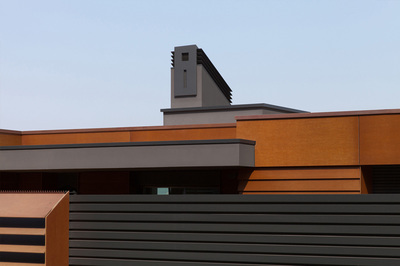RESIDENCE EKALI**
* 4th place in the category “Best First Building by a Young Architect of the years 2010-2012” in “DOMES 2013 Awards”
* Awarded in the Category Dwelling Houses by the Union of Bulgarian Architects In the National review of Bulgarian Architecture 2012
The house is located in a residential area in the Northern suburbs of Athens, on an extremely steep slope of the forest of Penteli Mountain. The architectural approach was dictated by the idea of the integration of the building into its natural environment and its affinity to the adjacent landscape. The subsequent maintenance of the liaison of the building with its environment aims at ensuring to all major rooms of the residence equal access to the natural landscape or its extensions on the green roofs.
The building follows the slope of the plot, generating stepwise five prevailing levels that convert the steep incline to a viable landscape and a sequence of versatile functions combining conventional uses with high-level requirements. Each of the five terraced levels meets a specific functional demand. The highest level of the building is accessed from the street, situated on the upper side of the plot. Two bridges, for vehicles and pedestrians respectively, lead in to the garage and the entrance area. A vertical naturally lit communication axis by means of a staircase and transparent lift lead the visitor gradually to the next lower 4 levels which accommodate resting, living and recreation spaces.
The selection of sustainable facade materials such as high-pressure laminate panels of cellulose for the ventilated facade and corten for the flashings of the green roofs was dictated by the necessity for morphological harmonization with the nature elements of the Pentelis forest landscape. The alterations of these materials caused by weathering, wear and tear, lend to the facade the identity of a living organism.
Apart from its aesthetic relevance, the 250sq.m of green roofs as well as the ventilated facade of the building, contribute to a comfortable surrounding microclimate and subsequently interior climate, relieving the building from the thermal loads during summer.











